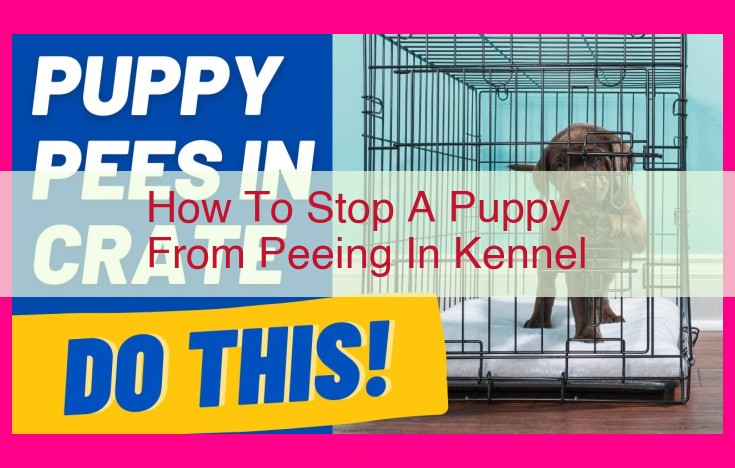Ultimate Guide: Potty Train Your Puppy To Stay Dry In Its Kennel

To prevent a puppy from peeing in its kennel, implement a consistent potty schedule, ensuring the kennel is the appropriate size and free from anxiety-inducing factors. Use crate training to establish a designated safe space for the puppy. Additionally, employ positive reinforcement techniques to praise and reward the puppy for appropriate elimination behaviors.
Understanding the Key Elements of Housebreaking a Puppy
Housebreaking a puppy is a crucial step in establishing a harmonious relationship with your furry friend. It requires patience, consistency, and a deep understanding of the key elements involved:
- The Puppy:
Your puppy is the central figure in this process. It’s essential to understand their individual needs, such as their age, breed, and temperament. Different breeds may require varying approaches to training.
- The Kennel:
The kennel is your puppy’s designated safe space. Choosing the right size is crucial, as a kennel that’s too large may encourage accidents. Use a crate to effectively limit their movement and prevent accidents.
- Housebreaking:
Housebreaking involves teaching your puppy to relieve themselves in a designated area. This requires a consistent potty schedule and positive reinforcement for desired behaviors.
- Positive Reinforcement:
Positive reinforcement is a key element in housebreaking a puppy. Rewarding your puppy with treats, praise, or play for successful potty breaks will help them associate these actions with positive outcomes and reinforce good behavior.
Essential Training Techniques for Housebreaking Puppies
When it comes to housebreaking a puppy, training is paramount. Two essential techniques that lay the foundation for successful potty training are crate training and command training.
Crate Training: A Safe Haven for Your Pup
Crate training offers numerous benefits for puppies. It provides them with a designated safe space where they can retreat, relax, and feel secure. Moreover, crates help prevent accidents by discouraging puppies from eliminating in their resting area.
To use a crate effectively, it’s crucial to choose the appropriate size. The crate should be large enough for the puppy to stand up, turn around, and lie down comfortably, but not so spacious that they can use one end as a potty spot and the other for sleeping.
Command Training: Empowering Your Puppy with Language
Command training is indispensable for effective communication with your puppy. By teaching commands such as “sit” and “stay,” you can control their behavior and communicate your expectations clearly.
Sit: The “sit” command teaches your puppy to assume a seated position on cue. This skill can be used to keep your puppy calm and focused during potty training, as well as in other situations where you need them to remain still.
Stay: The “stay” command teaches your puppy to remain in a specific position until released. This command is particularly useful during potty training, as it allows you to step away for a moment or take your puppy out on a leash without them wandering off.
Mastering these essential training techniques will provide you with the tools needed to effectively housebreak your puppy and foster a strong and rewarding bond with your furry friend.
Preventing Accidents: The Secret to a Clean Home
Housebreaking your furry bundle of joy is a journey that requires patience, consistency, and a deep understanding of your puppy’s needs. While accidents are inevitable, there are some key strategies you can implement to minimize them and create a positive training experience.
1. Establish a Regular Potty Schedule
- Puppies naturally eliminate after sleeping, eating, and playing. Establish a regular potty schedule around these times and stick to it consistently.
- Take your puppy outside frequently, especially after meals or naps. This will help them associate going potty with certain times and places.
2. Choose the Right Kennel Size
- A kennel that is too large will give your puppy ample space to eliminate in one corner, while avoiding the other.
- Conversely, a kennel that is too small can cause discomfort and accidents due to lack of space.
- Select a kennel that is just big enough for your puppy to stand, turn around, and lie down comfortably.
3. Manage Anxiety
- Separation anxiety is a common cause of accidents in puppies. Address this issue early on by providing your puppy with comfort and reassurance.
- Create a safe space for your puppy in the kennel with a soft blanket and toys.
- Gradually increase the time you spend away from your puppy, starting with short intervals and rewarding them for staying calm.
Troubleshooting Housebreaking Accidents
Housebreaking a puppy can be a rewarding experience, but it’s not without its challenges. If your puppy is having accidents despite your best efforts, don’t despair. There may be underlying factors contributing to the issue. Here are two common troubleshooting steps:
Health Conditions
Rule out any underlying medical issues that may be contributing to accidents. For example, a urinary tract infection or digestive problems can cause frequent urination or loose stools. If you suspect a health issue, consult your veterinarian for proper diagnosis and treatment.
Environmental Factors
Identify and address any environmental factors that may be causing accidents. The location of the kennel, for instance, can play a role. If the kennel is in a high-traffic area or near a window with distracting sights and sounds, your puppy may feel anxious and prone to accidents. Similarly, lack of sufficient exercise can lead to accidents as puppies may not have ample opportunities to relieve themselves outdoors.
By addressing health conditions and environmental factors, you can increase your chances of successful housebreaking and create a cleaner, more harmonious home environment for you and your furry friend.